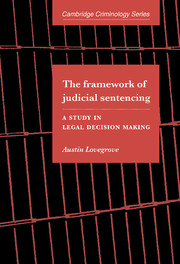Book contents
- Frontmatter
- Contents
- List of figures
- List of tables
- Acknowledgments
- 1 Judicial decision making and sentencing policy: continuation of a study
- 2 A sentencing decision model: single and multiple similar counts
- 3 A sentencing decision model: multiple disparate counts
- 4 Testing the decision model for multiple disparate counts
- 5 The techniques of data collection
- 6 Judges' thoughts on sentencing the multiple offender
- 7 An alternative sentencing decision model for the multiple offender
- 8 Validity and development of the alternative decision model: the data collection
- 9 Towards a requisite decision model for sentencing the multiple offender
- 10 The armature of judicial sentencing
- Appendix 1 Case 37 from Sentencing Research Exercise – Part 3B
- References
- Index
1 - Judicial decision making and sentencing policy: continuation of a study
Published online by Cambridge University Press: 22 August 2009
- Frontmatter
- Contents
- List of figures
- List of tables
- Acknowledgments
- 1 Judicial decision making and sentencing policy: continuation of a study
- 2 A sentencing decision model: single and multiple similar counts
- 3 A sentencing decision model: multiple disparate counts
- 4 Testing the decision model for multiple disparate counts
- 5 The techniques of data collection
- 6 Judges' thoughts on sentencing the multiple offender
- 7 An alternative sentencing decision model for the multiple offender
- 8 Validity and development of the alternative decision model: the data collection
- 9 Towards a requisite decision model for sentencing the multiple offender
- 10 The armature of judicial sentencing
- Appendix 1 Case 37 from Sentencing Research Exercise – Part 3B
- References
- Index
Summary
In sentencing, the judge's task is to determine the type and quantum of sentence appropriate to the facts of the case, and this judgment must be made in accordance with the relevant statutory provisions and appellate principles. But in Australia, as in England and elsewhere, sentencing law speaks in only general terms so that it is left to the sentencing judge to develop and apply the working rules required to give detailed effect to these provisions and principles in actual cases. What is not known is how individual judges have responded to this challenge. The present monograph is the second report from a continuing study of this matter. The first, Lovegrove (1989), examines how judges in Victoria scale and combine the seriousness of the offence characteristics, such as organization and violence, of a single count and use this to determine what is appropriate by way of sentence (quantum of imprisonment) for that count. The product of this work is a model offering both a decision strategy and a numerical guideline; since it takes no account of legally immaterial considerations or distortions in thinking arising from the limitations of human information processing, it represents an account of ideal (cf. actual) decision making in sentencing.
The present study extends that enquiry, being concerned with multiple-count cases: how in Victoria the judge, having fixed an appropriate sentence of imprisonment for each of the comprising counts, determines an effective sentence appropriate to the overall seriousness of the case.
- Type
- Chapter
- Information
- The Framework of Judicial SentencingA Study in Legal Decision Making, pp. 1 - 35Publisher: Cambridge University PressPrint publication year: 1997



